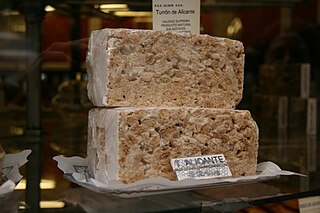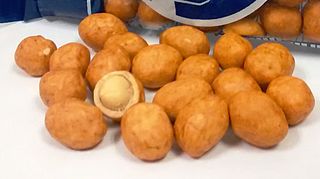
Confectionery is the art of making confections, which are food items that are rich in sugar and carbohydrates. Exact definitions are difficult. In general, however, confectionery is divided into two broad and somewhat overlapping categories: bakers' confections and sugar confections. The occupation of confectioner encompasses the categories of cooking performed by both the French patissier and the confiseur.

Pralines are confections containing nuts – usually almonds, pecans and hazelnuts – and sugar. Cream is a common third ingredient.

Turrón, torró and torrone is a southwest European and Moroccan nougat confection, typically made of honey, sugar, and egg white, with toasted almonds or other nuts, and usually shaped either into a rectangular tablet or a round cake. Turrón is usually eaten as a dessert food around Christmas in Spain, and Italy. It's also known in Portugal, Morocco, and Latin America.

An alfajor or alajú is a traditional confection typically made of flour, honey, and nuts. It is found in Argentina, Bolivia, Paraguay, the Philippines, Southern Brazil, Southern France, Spain, Uruguay, Peru, Ecuador, Colombia and Chile. The archetypal alfajor entered Iberia during the period of al-Andalus. It is produced in the form of a small cylinder and is sold either individually or in boxes containing several pieces.
Penuche is a fudge-like candy made from brown sugar, butter, and milk, using no flavorings except for vanilla. Penuche often has a tannish color, and is lighter than regular fudge. It is formed by the caramelization of brown sugar; thus, its flavor is said to be reminiscent of caramel. Nuts, especially pecans, are often added to penuche for texture, frequently in the making of penuche candies. It is primarily a regional food, found in New England and some places in the Southern United States, though in the latter it goes by different names, including creamy praline fudge, and brown sugar fudge candy.

Filipino Cuisine is composed of the cuisines of more than a hundred distinct ethnolinguistic groups found throughout the Philippine archipelago. A majority of mainstream Filipino dishes that compose Filipino cuisine are from the food traditions of various ethnolinguistic groups and tribes of the archipelago, including the Ilocano, Pangasinan, Kapampangan, Tagalog, Bicolano, Visayan, Chavacano, and Maranao ethnolinguistic groups. The dishes associated with these groups evolved over the centuries from a largely indigenous base shared with maritime Southeast Asia with varied influences from Chinese, Spanish, and American cuisines, in line with the major waves of influence that had enriched the cultures of the archipelago, and adapted using indigenous ingredients to meet local preferences.

A rice cake may be any kind of food item made from rice that has been shaped, condensed, or otherwise combined into a single object. A wide variety of rice cakes exist in many different cultures in which rice is eaten. Common variations include cakes made with rice flour, those made from ground rice, and those made from whole grains of rice compressed together or combined with some other binding substance.

Brittle is a type of confection consisting of flat broken pieces of hard sugar candy embedded with nuts such as pecans, almonds, or peanuts, and which are usually less than 1 cm thick.

Poha, also known as pohe, aval, pauwa, sira, chira, chivda, or avalakki, among many other names, is flattened rice originating from the Indian subcontinent. Rice is parboiled before flattening so that it can be consumed with very little to no cooking. These flakes of rice swell when added to liquid, whether hot or cold, as they absorb water, milk or any other liquids. The thickness of the flakes varies from almost translucently thin to nearly four times thinner than a normal rice grain.

Kalamay is a sticky sweet delicacy that is popular in many regions of the Philippines. It is made of coconut milk, brown sugar, and ground glutinous rice. It can also be flavored with margarine, peanut butter, or vanilla. Kalamay can be eaten alone; but is usually used as a sweetener for a number of Filipino desserts and beverages. It is related to the Chamorro dessert called Kalamai.

Panocha is a pudding made from ground sprouted wheat and piloncillo in New Mexico and southern Colorado,. It is traditionally eaten during Lent. The sprouted-wheat flour is called "panocha flour" or simply "panocha", as well.

A polvorón is a type of heavy, soft, and very crumbly Spanish shortbread made of flour, sugar, milk, and nuts. They are mostly produced in Andalusia, where there are about 70 factories that are part of a syndicate that produces polvorones and mantecados. Under the name mantecados, these sweets are a traditional preparation of other areas of the Iberian Peninsula and other Spanish-speaking countries as well.

Sesame seed candy is a confection of sesame seeds and sugar or honey pressed into a bar or ball. It is popular from the Middle East through South Asia to East Asia. The texture may vary from chewy to crisp. It may also be called sesame (seed)candy/bar/crunch; sesame seed cake may refer to the confection or to a leavened cake or cookie incorporating sesame.

Pastillas, also known as pastillas de leche, refer to a type of milk-based confections that originated in the town of San Miguel in Bulacan, Philippines. From San Miguel, pastillas-making spread to other Philippine provinces such as Cagayan and Masbate.

Japanese-style peanuts, also known as Japanese peanuts or cracker nuts, are a type of snack food made from peanuts that are coated in a wheat flour dough and then fried or deep-fried. They come in a variety of different flavors. The Mexican version's recipe for the extra-crunchy shell has ingredients such as wheat flour, soy sauce, water, sugar, monosodium glutamate, and citric acid. The snacks are sold in sealed bags.

Caycay is a Filipino crunchy layered cookie coated in syrup (latik) or honey and rolled in coarsely ground toasted peanuts. It originates from the islands of Bohol and Cebu and is a common specialty in the southern Visayas islands and Mindanao. The name comes from the verb kaykay which means "to dig up" in the Cebuano language, in reference to the step of coating the cookies in ground peanuts. Some versions coat the cookies in sesame seeds instead of peanuts.

Pinasugbo, also known as consilva, is a Filipino banana chip dessert made from thinly sliced saba bananas that are deep-fried and coated with caramelized sugar and sesame seeds. It originates from the Hiligaynon people of the Western Visayas islands. It is traditionally sold in white paper cones.

















